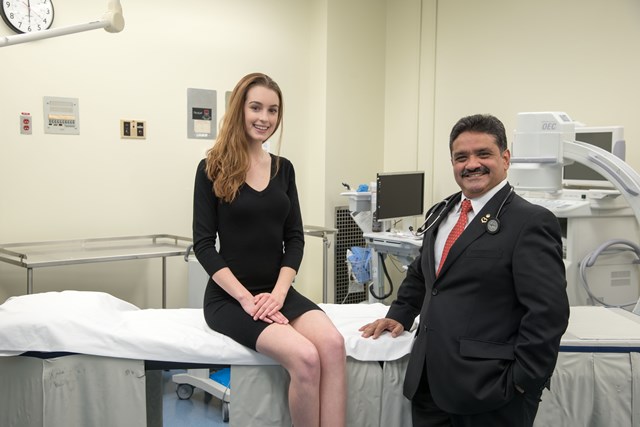By Jane Kitchen
Cardiac patient Jamie Dornan has survived sudden cardiac arrest. Twice.
The first time, she collapsed unexpectedly at her college, and was revived by a defibrillator wielded by a paramedic. The second time, thanks to the Central East Regional Cardiac Care Centre, a defibrillator implanted near her rib cage saved her life.
Dornan, 18, is susceptible to an irregular heartbeat, or arrhythmia. Specifically, she experiences episodes of ventricular fibrillation (VFib), where her heart beats so quickly it quivers and doesn’t pump. There is then no blood moving from the ventricle and the heart stops functioning. This leads to sudden cardiac arrest (SCA), and an individual at this stage only has minutes until death. Also known as the “silent killer,” as there are few to no warning signs, 85 to 95 per cent of those who have an SCA die before they get to hospital.
After Dornan’s first episode of SCA, she was referred to the Central East Regional Cardiac Care Centre, located at the Centenary site of Scarborough and Rouge Hospital (SRH). The Centre offers the only comprehensive cardiac arrhythmia program in the Central East Local Health Integration Network (Central East LHIN). After an initial assessment, she was referred to cardiologist Dr. Amir Janmohamed as a potential candidate for an implantable cardioverter-defibrillator (ICD), designed to shock an irregular heartbeat back into a normal rhythm.
Dornan was familiar with ICDs as a member of her family has the traditional transvenous ICD, implanted in the upper left chest wall under the collarbone, with electrical leads that are imbedded in the heart muscle. As she is just starting out as a model, Dornan was afraid that this type of ICD would spell the end of her career before it had even really begun. But Dr. Janmohamed suggested a solution that would save her life as well as her potential livelihood: a subcutaneous ICD (S-ICD™) system.
“Jamie was a model candidate for an S-ICD™, excuse the pun,” says Dr. Janmohamed. “First of all, it is less visible, which is ideal for her career choice. Second, as she is very young, she needs a device with a long livelihood. Most importantly, she didn’t need the pacemaker function of a transvenous ICD, but a defibrillator that will deliver a shock only in the case of SCA. This device fit all those criteria and was the best choice.”
The S-ICD™ has only been approved for use in Canada in the last two years, and is not yet widely in use across Ontario or even Canada. As a cardiac electrophysiologist specializing in electrical issues in the heart, Dr. Janmohamed is the only cardiologist in the Central East LHIN who does these implants and has completed several. But in Dornan’s case, his team met Dornan’s specific concerns and minimized her scarring: Dr. Janmohamed inserted the device using only two incisions rather than three, and he called upon Dr. Mansour Bendago, a plastic surgeon with SRH, to suture her implant incision.
“I’m so glad I went through with getting the defibrillator implanted,” says Dornan. “It is barely visible; you can’t tell it’s there even when I’m wearing a tank top. I’m grateful to Dr. Janmohamed for suggesting this and for Dr. Bendago for rearranging his whole schedule to close me after the device was inserted. I am healing very well and the scar is already fading. If I had to say one thing to anyone, whether you’re my age or older, go through with it. It’s worth it.”
Dornan knows exactly how much it’s worth – her life. Six weeks after the implantation, the device did its job, as it delivered “therapy,” or a shock, to her. “I was at a concert and started seeing black, so I got down on my hands and knees,” says Dornan. ”I woke up, laying on the floor, with a crowd staring at me. My friend said I was down for a minute and that my chest was trembling. The device saved my life.”
When Dornan checked in with Dr. Janmohamed after the cardiac event, he told her that the device shocked her heart back into a functioning rhythm within 16 seconds of entering VFib.
“Jamie would have died without the S-ICD™,” says Dr. Janmohamed. “In the big arena that she was in, it would have been highly unlikely that an external defibrillator, like the kind you see in public arenas and community centres, would have reached her in time. People with cardiac conditions can develop severe social anxiety, as they can be afraid to go anywhere or do anything in case something like this happens. This device takes away that worry.”
Dornan has been through a lot since that day last October when she first collapsed. While she was depressed when she first got out of the hospital with the realization of how completely her life had changed, she is now adjusting to her new reality: she has a cardiac condition that requires constant monitoring. But, her device has already proven that it can and will save her life.
“I couldn’t ask for a better outcome,” she says.
Jane Kitchen is a Communications specialist, Scarborough and Rouge Hospital.


